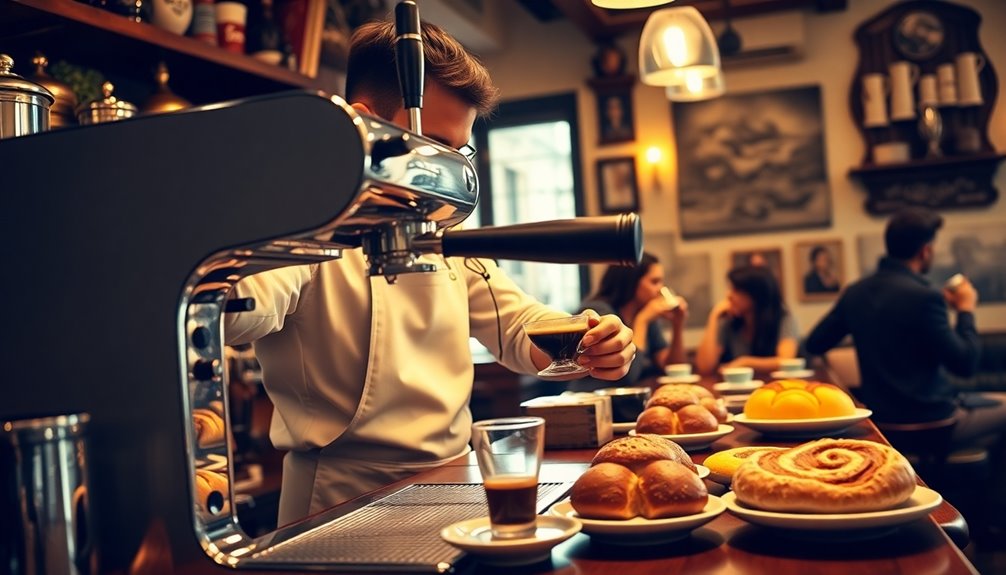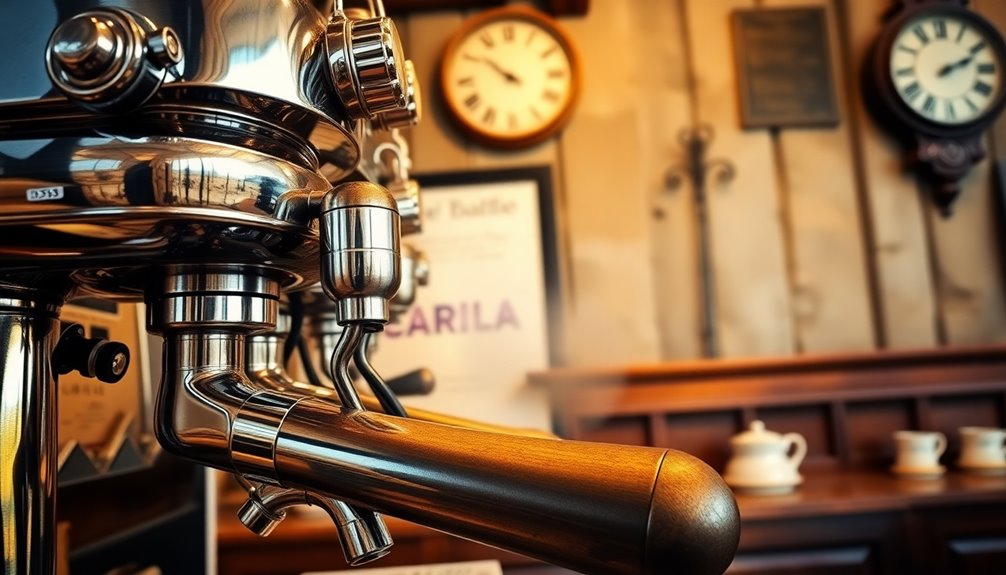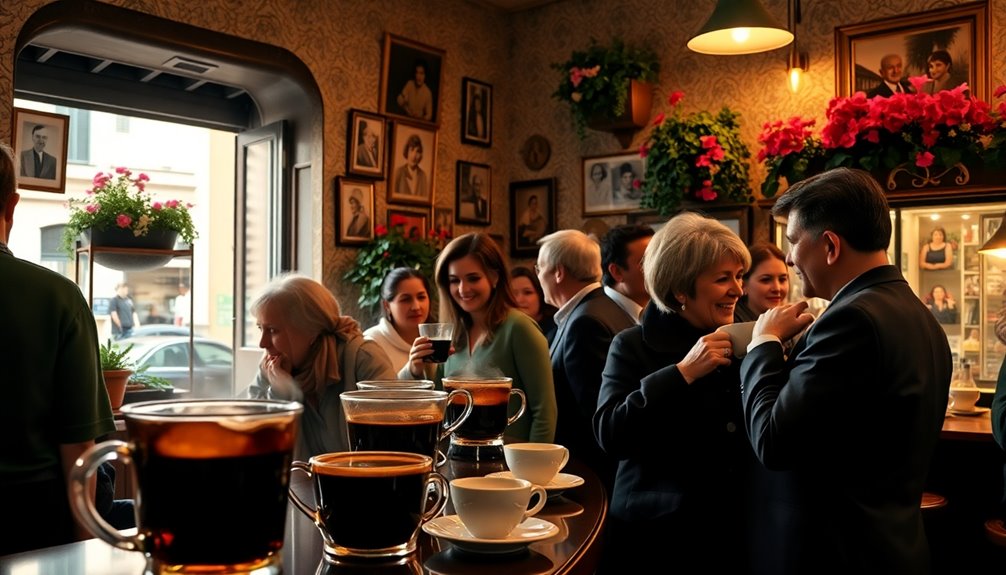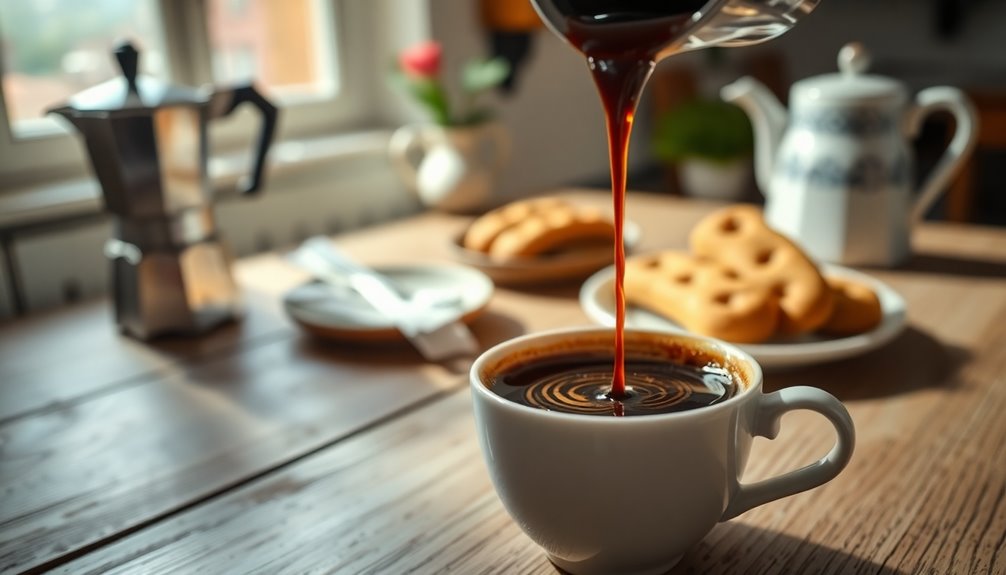Espresso is more than just a drink in Italy—it’s a cultural icon that symbolizes social interaction and daily rituals. You’ll find it served with a hazel-brown crema, delivering a rich aroma and balanced taste. Italians enjoy it as a quick treat, often shared after meals, reinforcing connections with friends and family. Local customs like “caffè sospeso” reflect community spirit. There’s a whole lot more to discover about espresso’s deep roots in Italian life and culture.
Key Takeaways
- Espresso serves as a cultural icon in Italy, symbolizing quality and social interaction among friends and family.
- Consumed quickly at bars, espresso fosters connections and creates a communal coffee-drinking experience.
- Local customs, like “caffè sospeso,” promote generosity and community spirit, enriching social ties.
- Each region in Italy has unique espresso variations, reflecting local culture and traditions.
- Espresso bars are vibrant hubs for social interaction, discussions, and artistic expression, emphasizing their role in daily life.
The Essence of Italian Espresso

Espresso is more than just a coffee; it’s a cultural icon in Italy. When you sip an authentic Italian espresso, you’re not just drinking coffee; you’re immersing yourself in a rich tradition.
The distinctive hazel-brown crema on top signifies quality, enhancing your overall coffee experience. As you inhale, the intense aroma of flowers, fruits, toasted bread, and chocolate envelops you, creating a complex olfactory journey.
A well-prepared espresso offers a round, velvet-like taste that balances sour and bitter flavors seamlessly. This iconic beverage is typically enjoyed as a standalone treat after meals, reflecting its importance in Italian culture as a social beverage. Additionally, coffee consumption in Italy is deeply rooted in social interactions, often serving as a backdrop for conversations and gatherings.
The Art of Brewing the Perfect Espresso

To truly appreciate the cultural significance of espresso, mastering the art of brewing it’s key. Start with high-quality coffee beans, ideally a blend of arabica and robusta, to achieve that authentic Italian espresso flavor.
Master the art of brewing espresso with high-quality arabica and robusta beans for an authentic Italian experience.
Grind the beans finely to create the right resistance during the brew, ensuring ideal extraction of flavors. Remember to store your coffee beans in an airtight container in a cool, dark place to maintain freshness.
- Preheat your cups to retain temperature and flavor.
- A well-brewed espresso should have a rich, hazel-brown crema on top.
- Serve and consume immediately to maximize the aromatic qualities. Additionally, brewing time should be carefully monitored to ensure the best flavor extraction.
Embrace these steps, and you’ll deepen your connection to Italy’s vibrant coffee culture.
Historical Milestones in Espresso Machine Development

You might be surprised to learn that the journey of espresso machines began with Angelo Moriondo’s 1884 prototype, which harnessed steam for quick brewing. This innovation paved the way for Luigi Bezzera’s 1901 patent that revolutionized coffee making, leading to the establishment of bustling espresso bars after World War II. Today, modern advancements continue to enhance the quality of espresso, transforming it into a beloved cultural staple. Additionally, the introduction of super automatic espresso machines has made it easier for home users to enjoy café-quality drinks with minimal effort.
Early Innovations and Prototypes
Although the journey of espresso machine development began in the late 19th century, it was marked by pivotal innovations that transformed coffee brewing.
You’ll find that these early prototypes set the stage for a revolution in Italian coffee culture.
- Angelo Moriondo created the first espresso machine in 1884, using steam for quick brewing.
- In 1901, Luigi Bezzera patented a design featuring multiple group heads for efficient coffee making.
- The collaboration with Desidero Pavoni led to the commercial espresso machine, Ideale, revealed at the 1906 Milan Fair.
These innovations not only shaped the history of coffee but also paved the way for modern espresso machines, making Italian bars the vibrant centers of coffee enjoyment they’re today. Additionally, the importance of color accuracy in espresso machines ensures that the brewing process maximizes the rich flavors of the coffee.
Rise of Espresso Bars
The innovations in espresso machine technology not only transformed the brewing process but also catalyzed the emergence of espresso bars across Italy.
With Luigi Bezzera’s patented machine debuting at the 1906 Milan Fair, Italians embraced espresso as a cornerstone of their coffee culture. The partnership between Bezzera and Pavoni popularized espresso, making it a staple in cafés.
By 1911, price regulations made espresso more accessible, leading to a surge in espresso bars where social interaction thrived over steaming cups of caffeine.
Companies like Gaggia and Faema further refined the espresso-making process, ensuring that these bars became essential gathering places.
Today, these establishments remain vibrant hubs for enjoying espresso and connecting with others.
Modern Machine Advancements
As espresso culture evolved, so did the machines that brewed it, marking significant milestones in coffee history.
You’ll find that each innovation has shaped the experience of coffee drinkers and elevated Italian culture.
- Angelo Moriondo’s 1884 prototype introduced steam brewing.
- Luigi Bezzera’s 1901 commercial espresso machine allowed multiple group heads for fresh coffee on demand.
- Post-WWII advancements by Gaggia and Faema guaranteed better quality and consistency in cafés.
These developments not only transformed how espresso-based drinks are made but also fueled the rise of coffee bars worldwide. The evolution of espresso machines reflects the importance of imagination mobilizing mental potential, as each advancement has contributed to a richer coffee experience.
Today, modern espresso machines continue to honor the rich heritage while catering to the ever-growing demand of coffee enthusiasts seeking the perfect cup.
A Guide to Drinking Espresso the Italian Way

When you think about drinking espresso in Italy, it’s all about rituals and social connections.
Mornings often start with a quick, strong shot at the bar, setting the tone for your day.
Embracing this culture means enjoying espresso as a moment to pause and connect with those around you. The experience is similar to enjoying local cuisine, as both emphasize the importance of fresh, locally sourced ingredients that reflect regional traditions.
Morning Coffee Rituals
Starting your day in Italy often means embracing a vibrant morning coffee ritual that centers around the beloved espresso. As you navigate the lively streets, you’ll find locals enjoying their morning coffee, often standing at the bar. This quick, communal experience reflects the fast-paced Italian life.
- Begin with a pastry and a milky coffee, like cappuccino or caffè latte, but remember—these milky drinks are only for the morning.
- Indulge in a classic espresso, known as caffè, served as a small, dense shot.
- For a lighter option, try a caffè macchiato, which features a splash of milk.
This morning routine not only energizes your day but also connects you with the vibrant culture around you. Additionally, the use of energy-efficient appliances in Italian cafes showcases a commitment to sustainability while enhancing the coffee experience.
Social Espresso Culture
Though it may seem simple, drinking espresso in Italy is a rich social experience that embodies the country’s culture.
When you visit a bar, you’ll notice Italians drink their espresso quickly, standing rather than sitting. This fast-paced interaction fosters connections, as patrons exchange greetings and enjoy a moment of camaraderie.
After meals, you’ll order your espresso simply as “caffè,” savoring that small, dense shot of coffee often accompanied by a glass of water.
Remember, milk-based coffees like cappuccinos are reserved for the morning.
Also, look out for the practice of “caffè sospeso,” where you can pay for an extra coffee, showcasing the generosity that’s integral to Neapolitan coffee culture.
Embrace the moment—it’s about more than just the drink! Additionally, this social ritual can enhance emotional regulation as it provides a supportive environment for interaction and connection.
Espresso and Its Role in Daily Life

Espresso plays a central role in daily life in Italy, seamlessly blending into the rhythm of the day. You’ll often find Italians enjoying their espresso at bars, savoring it as a quick social break. This ritual typically occurs after meals, aiding digestion rather than accompanying food.
- Milk-based drinks like cappuccino are reserved for mornings, maintaining digestive health.
- The espresso drinking culture fosters social connections, making coffee breaks an opportunity to catch up with friends or colleagues.
- The practice of caffè sospeso highlights community spirit, as patrons pay for an extra coffee for someone in need. Additionally, similar to regional water parks, espresso bars often serve as vibrant community hubs that enhance local culture and social interaction.
Regional Variations in Italian Coffee Culture

While you might associate Italian coffee culture primarily with espresso, each region of Italy offers its own unique coffee traditions that reflect local tastes and customs. Here’s a glimpse into some regional variations:
| Region | Coffee Tradition |
|---|---|
| Le Marche | Caffè anisette, flavored with anise |
| Sicily | Caffè dun parrinu, spiced Arabic coffee |
| Naples | Caffè sospeso, a community-driven custom |
| Turin | Caffè al Bicerin, coffee with chocolate |
In Naples, you’ll find a strong caffè napolitano, consumed quickly in lively social settings. Meanwhile, in Turin, rich flavors take center stage, highlighting the diversity of Italian coffee. Each caffè reveals a story about its region, making Italian coffee culture truly enchanting.
The Social Ritual of Coffee in Italy

As you step into an Italian café, you’ll quickly notice that coffee isn’t just a beverage; it’s a social ritual that brings people together.
At the bar, you’ll witness friends and colleagues enjoying a quick espresso, emphasizing social interaction over leisurely sipping. The phrase “prendiamo un caffè” embodies the essence of coffee breaks as cherished moments of connection.
- The tradition of caffè sospeso highlights the community spirit, allowing you to pay for an extra drink for someone in need.
- After meals, Italians savor espresso, enjoying it as a standalone treat rather than with food.
- Cafés serve as cultural hubs, fostering discussions and artistic expression, making coffee an essential part of Italian life.
Famous Coffee Spots Across Italy

Italy’s coffee culture boasts a rich tapestry of historic cafés that reflect the nation’s passion for this beloved beverage. Each coffee house is a cultural landmark, offering a unique experience steeped in tradition.
| Coffee Spot | Location | Notable Feature |
|---|---|---|
| Caffè Florian | Venice | Oldest operating coffee house |
| Caffè al Bicerin | Turin | Unique chocolate-coffee combo |
| Antico Caffè Greco | Rome | Frequented by famous artists |
| Gran Caffè Gambrinus | Naples | Celebrated literary salon |
When you sip a traditional Italian espresso at these spots, you’re not just enjoying a drink; you’re participating in a rich history that connects generations through the love of caffè.
Bringing Italian Espresso Home

If you want to bring the authentic taste of Italian espresso into your kitchen, start by investing in high-quality coffee beans roasted in Italy.
Using finely ground coffee is essential for creating the right resistance during brewing, ensuring you achieve that rich crema and flavor profile.
Consider using either an espresso machine or a Moka pot, both of which can produce a strong coffee reminiscent of traditional espresso.
- Preheat your espresso cups to maintain ideal temperature.
- Brew your coffee and consume it immediately for the best aroma.
- Pair your espresso with authentic Italian pastries to elevate your experience.
Frequently Asked Questions
What Is the Espresso Culture in Italy?
When you immerse yourself in espresso culture in Italy, you’ll find it’s all about quick, communal experiences.
You might stand at the bar, savoring a shot of rich, intense coffee, embracing the bustling atmosphere.
You’ll notice Italians enjoy their espresso after meals, celebrating its bold flavors.
Plus, if you’re in Naples, you might come across caffè sospeso, where you can pay for a coffee for someone else, reflecting the community spirit that’s so essential here.
Why Do Italians Love Espresso so Much?
Italians love espresso because it’s more than just a drink; it’s a vibrant part of daily life.
You savor its rich, bold flavor, which provides a quick pick-me-up and enhances social interactions. The ritual of grabbing a shot at a bar fosters connections with friends and colleagues.
Plus, the efficiency of enjoying it standing up aligns perfectly with your fast-paced lifestyle, making espresso a beloved staple in your everyday routine.
What Is the Italian Rule for Espresso?
Imagine standing at a bustling café bar, the aroma of rich coffee swirling around you.
The Italian rule for espresso is simple: it’s mostly enjoyed as a quick shot while standing, especially after meals. You’ll notice that cappuccinos are reserved for mornings, and ordering a “caffè” means you’re getting a small, strong espresso.
Italians savor these moments throughout the day, letting each sip energize and connect them to the vibrant atmosphere around them.
What Is the Original Meaning of Espresso in Italian?
The original meaning of “espresso” in Italian comes from the word “esprimere,” which means “to express.”
This reflects how the brewing process quickly extracts flavors under pressure.
You’ll find that espresso is designed to be made on demand, emphasizing fresh, intense flavors.
When you enjoy a shot of espresso, you’re experiencing a method that captures the essence of coffee in a concentrated form, perfect for a quick, flavorful pick-me-up.
Conclusion
In Italy, espresso isn’t just a drink; it’s a heartbeat that pulses through daily life. Picture yourself standing at a bustling café, the barista expertly pulling shots as you savor the rich aroma. Just like a well-tuned symphony, each sip resonates, connecting you to centuries of tradition and community. Embracing espresso means embracing a culture that celebrates the moment—so go ahead, take that sip, and let the essence of Italy awaken your senses.









